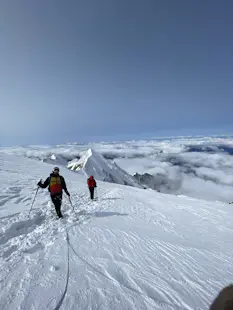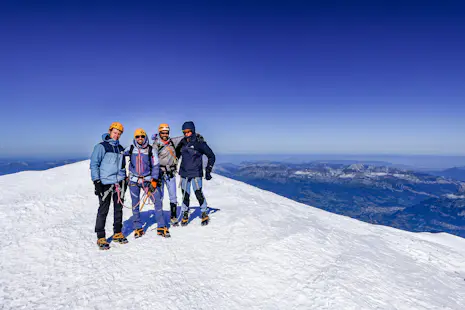




Mont Blanc Acclimatization and Ascent
Summit Western Europe's highest peak - Mont Blanc - on this epic 6-day guided adventure! Master glacier travel, acclimatize to the altitude, and experience breathtaking landscapes with certified guides before reaching the iconic summit.
TRIP TYPE
Group
MOUNTAIN RANGES
Alps
DURATION
6 Days
OFFER PERIOD
Jun - Sep
FITNESS LEVEL
high
SKILL LEVEL
Intermediate
PAYMENT METHODS
Credit Card, Wire Transfer and more!
Description
Description
Have you ever dreamed of reaching the summit of Mont Blanc, the highest peak in Western Europe? This 6-day program is designed to make your dream a reality!
Maximize your chances of reaching the summit by dedicating the first three days to acclimatization and acquiring essential glacier hiking techniques - learn how to walk with crampons, use an ice axe, and rope up for safety on the mountain!
Explore the stunning Tour and Trient glaciers during your acclimatization hikes. You'll also climb Tête Blanche, a beginner-friendly summit at 3429 meters (11,247 ft). This climb is a perfect opportunity to practice your crampon technique and prepare yourself for the challenges ahead. After your acclimatization hikes, you'll return to the valley for a well-deserved night's rest before the big ascent of Mont Blanc.
The ascent of Mont Blanc will take place over the next three days. You'll follow a gradual climb that takes you through the Dôme du Goûter and the ridge of Bosses. Finally, your efforts will be rewarded with breathtaking views from the summit and an unforgettable adventure shared with your experienced guide.
Don't miss this opportunity to turn your dream into a reality! Contact us to start your Mont Blanc journey.
Price includes
Price includes
- Guiding fee
- Lunch
- Dinner
- Breakfast
- Accommodation included
Secure your spot with just 25% payment
48-hour free cancellation with 30-day advance booking
Itinerary
Itinerary
Day 1: Journey to Albert 1er refuge
Join us for an exciting start to your ice and snow school adventure on the right bank of the Tour glacier. Upon arrival, you will meet with your guide at the equipment rental store for individual equipment setup (retrieval for those who have pre-requested it), as well as a briefing session.
Afterward, we'll start our journey to the village of Le Tour, approximately 20km away, via minibus. From there, we'll ascend via the Col de Balme ski lifts, eventually reaching the Albert 1er refuge at an altitude of 2702 meters on the right bank of the Tour glacier.
In the afternoon, near the refuge, the snow and ice school awaits, providing a captivating learning experience against the backdrop of the stunning glacier.
- Elevation Gain: Approximately 500m
- Maximum Altitude: 2702m
- Accommodation: Enjoy dinner and spend the night at the picturesque Albert 1er refuge
Day 2: Ascending Tête Blanche
Setting off from the Albert 1er refuge, we prepare our crampons in preparation for the ascent of Tête Blanche, a peak culminating at 3429 meters above sea level. Our journey continues as we traverse the Col Supérieur du Tour, ultimately arriving at the Trient cabin situated at 3170 meters.
- Elevation Gain: Approximately 850m
- Elevation: Around 850m
- Maximum Altitude: 3429m
- Accommodation: Indulge in dinner and spend the night at the welcoming Trient cabin.
Day 3: Col Supérieur du Tour
Starting from the Trient cabin, we'll ascend the Col Supérieur du Tour. Then we'll return to the Albert 1er refuge for a brief interlude before starting our descent towards the village of Le Tour.
Once in the village, we'll continue our descent back to the refuge and eventually to the village of Le Tour. Upon our return to the lodge, the guide will gather with the group to discuss the remainder of the itinerary, taking into account the current weather forecast and mountain conditions.
Additionally, the guide will provide training for the teams preparing for the ascent of Mont Blanc.
- Elevation Gain: Approximately 400m
- Elevation: Around 1000m
- Maximum Altitude: 3235m
- Accommodation: Spend the night in a lodge at the Tour.
Day 4: Climb to the Tête Rousse refuge
Starting from the Mont Blanc tramway station to Nid d’Aigle, we climb towards the Tête Rousse refuge, perched at 3167 meters. This initial stage serves as a gentle introduction to our Mont Blanc ascent.
Our journey begins in the late morning as we head towards the village of Les Houches, where additional guides join the group and ropes are prepared for the climb.
We ascend to Bellevue via cable car, then continue to Nid d'Aigle aboard the Mont Blanc tramway. The route initially leads us beneath the Rognes ridge, followed by a hike across the north face, before emerging onto a snowy plateau leading to the Tête Rousse refuge.
Once there, the afternoon is dedicated to rest and acclimatization, affording us the opportunity to revel in the exquisite vistas of the north face of Bionnassay.
- Elevation Gain: Approximately 1300m
- Maximum Altitude: 3167m
- Accommodation: Enjoy dinner and spend the night at the Tête Rousse refuge.
Day 5: Conquer Mont Blanc!
This challenging Mt Blanc ascent follows the rocky slope of the Aiguille du Goûter. A wide corridor at the base of the slope is susceptible to rockfall, emphasizing the importance of following the guide’s instructions.
The climb will then feature sections equipped with cables or ropes. As night falls, time seems to dissolve, and we ascend to the Dôme du Goûter at 4304m. Here, the Vallot bivouac refuge, though unattended, provides a potential sanctuary for mountaineers in need.
With the dawn, renewed energy accompanies the warming sun as we draw closer to the summit. The Bosses ridge emerges. Your guide will ensure the rope is securely taut as you navigate this awe-inspiring ridge.
After surmounting the final hump, the ridge broadens, unveiling the vast and inviting summit. Welcome to the pinnacle of Mont Blanc at 4810m!
- Elevation Gain: Approximately 1700m
- Elevation: Around 1000m
- Maximum Altitude: 4810m
- Accommodation: Enjoy dinner and spend the night at the Goûter refuge.
Day 6: Descent to Chamonix
Returning to Chamonix, the descent follows the familiar path towards Nid d'Aigle, where we catch the Mont Blanc Tramway. Upon reaching Les Houches via cable car, we rendezvous with our vehicles.
Lunch can be enjoyed either upon arrival of the cable car at Bellevue or in Chamonix after returning your equipment.
- Elevation: Approximately 1300m
- Maximum Altitude: 3167m
Details
Details
Accommodation
Shared rooms (dormitories) with blankets provided. You can bring a sheet for extra comfort (like a sleeping bag liner).
About the guide: Montagne Expédition
About the guide: Montagne Expédition

Montagne Expédition
4.90
(16)
Guide Agency
Languages
English | French
What people are saying about Explore-Share
What people are saying about Explore-Share
Kumari
5.00
I’m extremely happy with the ease with which I could book via your site reliable and experienced guide. Thank you so very much, and I’ve started to recommend your site to my friends. Dimitris is not only an awesome guide, but a wonderful person who was always looking out to give me the best experience I can have when he found out how much I love climbing! He is the Best!
Niklas
5.00
I am very pleased with Explore-Share! This was my first international climb, and the communication and response time were great. Herbie is a very skilled guide and very efficient. The entire booking process & payment was smooth. I will definitely use Explore-Share again. Thank you.
Greg
5.00
I was looking for a local guide for a hike I was planning and came across Explore-Share. They seemed to have good reviews and so decided to give them a try. The experience was very positive and completely happy with their service. I will be using them again for next trip.
Colin
5.00
Easy to set up and find the perfect trip. Informative site that is easy to use. Guides are all great to work with and communicate all arrangements needed. As simple as can be!
Lesley
4.00
Thank you explore-share for a wonderful via feratta experience. We have been wanting to learn for a long time but don't have the facilities in Scotland. The guide Mitja was extremely helpful and knowledgeable, answering all my many questions and providing advice. On the day head to take another group but he quickly arranged another guide Borut, who was brilliant. We had a fantastic morning learning via ferrata at Hvadnik in the gorge. It gave us the confidence to later hire our own equipment and go out in Mojstrana. Altogether a five star + experience. Thank you.
Join our newsletter!
Stay up-to-date on the best adventures.








